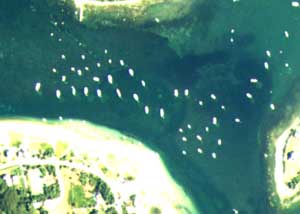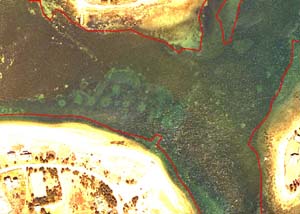Physical Disturbance to Eelgrass in Buzzards Bay
Figure 1. Mooring chain scour scars in the outer West Falmouth harbor area in June 2001 (left) and in March 2005 (right, image contrast and brightness enhanced). Click on each image to enlarge.
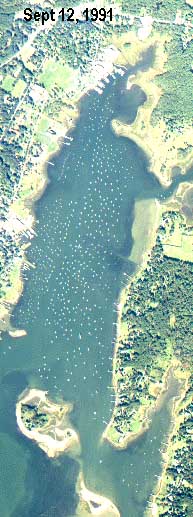
Figure 5. Dense mooring field in Sippican Harbor, Marion, MA circa 1991. The dark areas south of Ram Island at the bottom of the photograph is eelgrass. Today about 85% of these moorings have helix anchors, but they do not have elastic rodes.
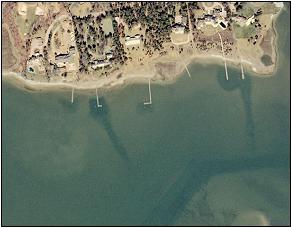
Figure 6. Channels dredged to docks in a Cape Cod embayment, East Bay in Osterville, MA.
Eelgrass was once prevalent here; in fact the channel at the left was dredged through eelgrass, and was the site of the first permitted eelgrass transplantation in Massachusetts in 1984. The loss of eelgrass in this estuary during the 1990s was due largely to coastal eutrophication.
Physical Disturbance of Eelgrass
by Dr. Joe Costa
Mooring Chain Scour and Prop Wash
As the wind changes direction, boats and their mooring floats and chains are pushed in different directions. As the boats move, their chains are dragged along the bottom. This action can uproot eelgrass and suspend silt into the water column. The physical loss of eelgrass from this action is clearly shown in the Figure 1 above. Some of the above losses could also be the result of boat prop wash, which can cause the physical ejection of sediment and grass. Prop wash can be more damaging at low tide, and some of the apparent “paths” near the moorings may be the result of a boat following a consistent departure or arrival approach to the mooring.
A close up of the mooring scars in Figure 1 is shown in more detail in Figure 2. As shown, some of the larger scars are up to 40 feet in diameter (>1200 square feet disturbed for some moorings). The total area defined in Figure 2 is 0.9 acres. This site may be a good candidate for conservation moorings (Figure 3, and see NOAA link below).
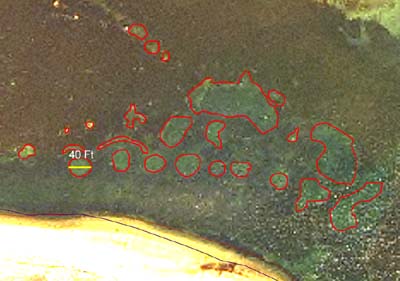
Figure 2. Detail of estimated disturbed area (red polygons) in March 2005 photograph from Figure 1 above. The total area defined in this portion of the photograph is 39,870 sq feet, or 0.9 acres
Chain scour from moorings also disturbs infauna (animals living in sediments), and can create a depression around the anchors that may accumulate drift algae (Figure 4). Chain scour is also discussed in this 2004 letter to the Wareham Marine Resources Commission, and Figure 4 below is taken from that correspondence.
In dense boat mooring fields, like the photograph of Sippican Harbor, Marion, MA in Figure 5, a considerable amount of silt may be suspended in the water column by this process, and may be an important contributor of reduced water transparency in that embayment. Nearly 1000 moorings are sited in Sippican Harbor. The Town of Marion, through the Marion Waterways Regulations, now requires that boats above 25 feet have helix anchors instead of blocks or mushroom anchors (85% of the moorings now have such anchors, pers. comm. Harbormasters Office). However, the town has not yet required elastic rodes, so chain scour remains an issue in this harbor.
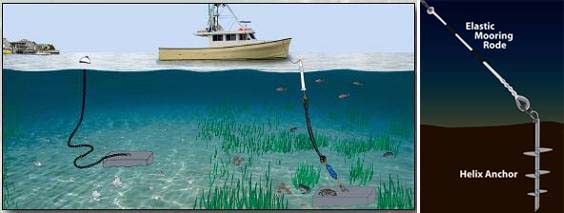
Figure 3. Traditional versus elastic rodes on moorings (left image taken from this NOAA conservation mooring fact sheet). Most “conservation moorings” would also have helix anchors (right) to minimize bottom habitat loss and current scouring associated with cement blocks or steel mushroom anchors.
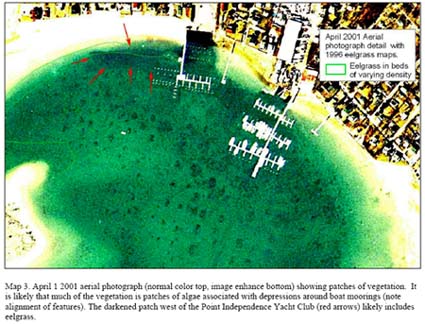
Figure 4. Map from 2004 letter to Wareham MRC. The darkened circular areas around the mooring blocks or anchors (dots in the photograph) may be accumulated drift material in the depressions around the anchors.
Sediment resuspension from Boat Prop Wash
As noted above, prop wash can disturb sediments and uproot eelgrass. This occurs from boats with boat inboard and outboard motors, and boats with impeller jet engines and jet skis. Sediment resuspension may worsen water clarity, and cover eelgrass leaves to the extent that the plants are shaded and begin to die off and disappear from portions of embayments. Prop wash and water skiing may have contributed to eelgrass loss in certain embayments in Buzzards Bay, and exacerbated impacts from eutrophication.
Jet Clamming
In Bourne, hydraulic fishing for clams, sometimes referred to as “jet-clamming” is allowed, and was particularly prevalent in the 1980s and 1990s. During the 1980s in Little Buttermilk Bay, plumes of sediments, and considerable rafts of dislodged eelgrass, were observed from this activity. Some residents also asserted that this activity was causing erosion of shorelines in some areas, and filling of channels with fine materials. This issue was discussed in this Presentation to the Bourne Shellfish Advisory Committee
Dredging Impacts
Dredging through eelgrass beds is generally prohibited, and where it is allowed, eelgrass restoration is required. In Figure 6, the channel to the left was dredged through an eelgrass bed in the 1980s. Eelgrass has since declined in this estuary (East Bay, Osterville) due to eutrophication. See the MEP report for Three Bays
Links and References on Seagrass Disturbance
NOAA: website: Protecting eelgrass habitat through the use of conservation moorings
Updated Buzzards Bay CCMP, Action Plan 6: Managing Impacts from Boating, Marinas, and Moorings
Texas Parks and Wildlife Website: Propeller Scarring in seagrass beds
Assessing the impact of boat propeller scars on fish and shrimp utilizing seagrass beds
Presentation to the Bourne Shellfish Advisory Committee: Causes of Eelgrass Degradation and Jet-Clamming Issues
PDF fact sheet on Massachusetts DEP eelgrass mapping program, and the Wetland Conservancy Program
